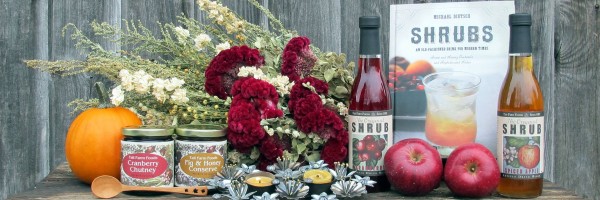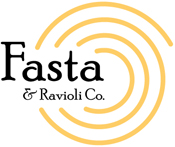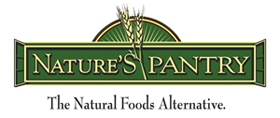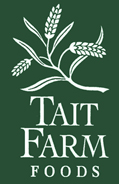-

Erin Donahue -

Christina Barkanic -

Brittany Trott -

Emily Wiley -

Jessica Reilley -

Chris Raines -

Will Nichols -

Emily Reddy -

Michele Marchetti -

Michele Frank -

James Gherardi -

Kit Henshaw -

Christina and Erin -

Kim Tait -

Erin McKinney -

Steve Spanelli -

Sam Komlenic -

Katherine Taylor Grofic -

James Eisenstein -

Jamie Oberdick -

Anna Lombardo -

LacCreta Holland -

Tony Ricci -

Local Food Journey -

Laura Young -

Kristin Camplese -

Harrison's Fresh + Local -

Danielle Matalonis -

Kristine A. -

Linda Weaver -

Naomi Elle Schwartz -

Dana Stuchul -

Cara McShane -

Brittany Smith -

Jessica Illuzzi - Frosty
-

Jessica Paholsky -

James Sechrengost -

Brad Yeckley -

Maya Althouse -

Jordan Reabold -

Kim Chase -

Maria Bryant - Alexandrea Scott
Shrubs are an “old-fashioned drink for modern times”
Posted by Anna Lombardo on 11/20, 2014 at 09:17 AM

Tait Farm shrub and Michael Dietsch's book, "Shrubs". Photo by Tait Farms
Though summer seems like a long way off (and it is, as my newly frozen hair indicates), it’s never a bad thing to plan ahead a few months. For those seeking out a refreshing drink to try at their summer dinner parties—or really anyone just looking to add another item to their drink mix—I introduce you to shrubs. And for most (read: all) of my information on shrubs, I turn to author Michael Dietsch, whose book, Shrubs, was published on October 6 by The Countryman Press.
A shrub, Dietsch tells me (and states in his book), is an acidulated beverage, or a drink made with some type of acid—historically vinegar, lemon juice, or other citruses. This acid is mixed with sugar, water, and sometimes alcohol; then, to give the drink a unique flavor, a fruit or a type of fruit juice is steeped in the mixture. Though the acidic components might seem unpalatable in what would be an otherwise sweet beverage, they were orginially a practical component. “Vinegar used to preserve fruit after the harvest,†Diestch says. “This was in a time before refrigeration.â€
This explains why shrubs were, before I wrote this article, unfamiliar to me: once refrigerators became popular, preservatives were no longer needed to keep fruit fresh. Consequently, the tasty by-product of the preservation process—namely, shrubs—started to disappear. For this reason, the drink has earned itself a spot on the Ark of Taste, a project with international reach being conducted by the Slow Food Foundation for Biodiversity, which is essentially an “endangered species list†for foods. However, it may not remain on this list long; Dietsch, in his book, observes that today the shrub is undergoing a “renaissance.†After the shrub-making tradition was maintained by the Pennsylvania Dutch for a time, a farm very close to home—Tait Farm—picked up the recipe and began making them in the late 1980s. Now, the drink is making rounds in bars all over the world.
The author himself discovered shrubs on a hot July day in 2008, when he visited Tales of the Cocktail (a cocktail festival) in New Orleans. He had read about shrubs before but had never tried one, and it was the first thing he drank at the festival. “The tartness of the vinegar was just refreshing,†Dietsch says. “They had the recipe printed on a card, [so] I recreated it [at home]; I loved it and my wife loved it.â€
Dietsch, in turn, put together a book that not only details the drink’s history and more closely examines the linguistic origins of the word “shrubâ€, but also supplies readers with over 50 different recipes, as well as shrub-inspired twists on old classics. There are plenty of gorgeous photographs paired with the recipes, though they do cause me some anxiety only because I know that I’ll never be able to scatter elderberries across a wooden table as artfully as the book does. The text is simultaneously accessible—Dietsch’s stories and explanations are clear to read and understand—and thorough in its scope. Dietsch tells me that he wanted to make sure readers had some sense of the history while enjoying the drink, so he researched extensively, using resources like Google books to get his information.
I ask Dietsch whether he makes use of local foods for his own shrubs, and he tells me that though he doesn’t want to get “too hung up†on locavore habits, the resources are there for those who want to make use of them. Local ingredients and ingredients from supermarkets both work equally well when making a shrub. Dietsch says he does like to get fruit from farmers’ markets when he can, noting especially the use of “second hand fruits,†or fruits that are bruised in some way. These are fruits that you wouldn’t necessarily serve “out of hand,†but work well in a shrub because the solid portion of the fruit is removed before serving. In this way, fewer foods go to waste. One important note: the fruit of choice in a shrub doesn’t necessarily have to be a fruit. In addition to common choices like pineapples, kiwis, oranges, and various berries, vegetables like carrots and kale can also make uniquely savory beverages.
If you’re still hesitant to consume a combination vinegar and fruit/vegetable drink, try to find some solace in Dietsch’s advice. “I like to compare a well-made shrub to a tart lemonade,†he says. “In a well-made shrub, you don’t really taste the vinegar itself. You just taste it as a complex tartness, as a backbone to the drink. The tartness is in balance with the fruit flavor and the sugar. It is harmonious, complex, and fruity.â€
So next summer, or over the winter (if you need something to remind you that the warm weather will return again someday), raise your shrub to Michael Dietsch, and to the traditions that allowed the drink to make its way to your home.
Shrubs are available at Tait Farms via their store or website, and can be also found at other locations including Way Fruit Farm.
![]() Author: Anna Lombardo
Author: Anna Lombardo
Bio: Suburban Philadelphian English major at Penn State Avid learner, runner, and eater
- Our Local Food Journey comes to an end
- Winter isn’t a quiet time at the farm
- Get the taste of garden season right now by growing herbs indoors
- All you need to know about PASA’s Farming for the Future conference









NO COMMENTS